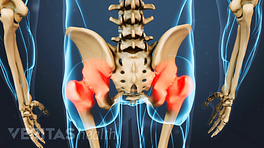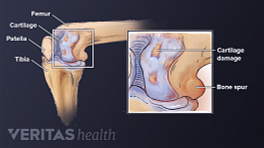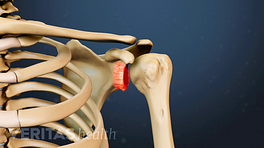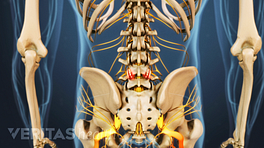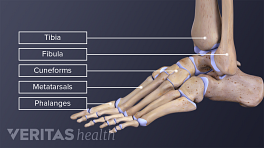There are many conditions related to degenerative arthritis. Some conditions exhibit symptoms similar to those of degenerative arthritis, some can result from degenerative arthritis, and some can even lead to the development of degenerative arthritis.
In This Article:
- Types of Arthritis
- Degenerative Arthritis
- Conditions Related to Degenerative Arthritis
- Inflammatory Arthritis
- Conditions Related to Inflammatory Arthritis
- One grouping consists of diseases influencing the release of growth factors and thereby affecting the proper growth of bone. These include: Achondroplasia, Acromegalic arthropathy, and Acromegaly.
- Avascular necrosis (osteonecrosis or “bone death”) - a bone disorder causing decreased blood and nutrient supply and eventual bone collapse in the affected area.
- Basal joint arthritis – the basal joint located at the base of the thumb is commonly worn out from normal use causing arthritic symptoms.
- Blount’s disease – a growth disorder causing the shin bone to angle inward, creating a bow-legged appearance and leading to joint disability if uncorrected.
- Chondromalacia patella – a softening of the cartilage of the kneecap that eventually causes the kneecap to rub directly against the lower thighbone.
- Corticosteroid-induced osteoporosis – steroid use disrupts the balance between bone growth and bone breakdown, causing bones to become porous and easily prone to breakage.
- Diffuse idiopathic skeletal hyperostosis (Forestier’s disease) – a degenerative form of arthritis characterized by excessive growth of the bones along the sides of the vertebrae and spine. Problems can also progress to the elbow, knee, and heel of the foot.
- Ehlers-Danlos syndrome – a grouping of genetic disorders that affect the connective tissues supporting various parts of the body including skin, muscles, tendons, and ligaments. Improperly constructed collagen causes the tissue to lose strength and elasticity.
- Epicondylitis – also known as tennis or golf elbow, epicondylitis describes the inflammation and degeneration of the tendon that attaches to the bony part of the elbow.
- Erosive osteoarthritis – a progressive disorder causing erosion of cartilage, mostly in the hands although other joints can be affected.
- Exercise-induced compartment syndrome – this condition causes pain over the front of the shinbone, usually occurring after periods of activity.
- Fabry disease – a fat storage disorder caused by an enzyme deficiency. There is evidence of a link between Fabry’s disease and connective tissue disorders including osteoarthritis.
advertisement
- Flat feet – feet with low arch and high flexibility can place damaging pressure on joints including toes, heels, knees, hips, and back.
- Freiberg’s disease – a condition characterized by enlargement of the head of a bone in the foot. The enlargement is the result of regeneration after injury and blood loss to bone while the skeleton is still developing.
- Gaucher disease - an inherited metabolic disorder in which harmful quantities of glucocerebroside accumulate in the spleen, liver, lungs, bone marrow, and even brain. Bone pain and loss of blood supply can cause arthritis symptoms, especially in the hips, shoulders, and spine.
- Hemarthrosis – a condition resulting from bleeding in the joints, most often due to injury or hemophilia. The presence of blood in the joints causes inflammation and can cause the bone to erode.
- Hip dysplasia – a group of hip problems, often relating to loose connective tissues and body positions that place undue stress on the area. This can lead to arthritis later in life.
- Hurler syndrome – an inherited metabolic disorder marked by progressive physical and mental deterioration. Nerve compression and restricted joint movement are common.
- Impingement syndrome – a condition affecting the rotator cuff, causing shoulder pain. Shoulder impingement syndrome is a symptom of:
- Joint hypermobility syndrome – a condition characterized by abnormally increased mobility of the joints. Misplaced wear and tear can lead to osteoarthritis.
- Kienböck’s disease – a deterioration of a bone in the wrist caused by loss of blood supply to the bone.
- Legg-Calve-Perthes disease – unexplained bone damage in the thigh from loss of blood supply. Treatment aims to avoid severe degenerative arthritis.
- Marfan syndrome – an inherited condition that affects the connective tissue, making it defective. Because connective tissue is located throughout the body, many parts can be affected including the skeleton, joints, and organs.
- Medial plica syndrome – inflammation occurring from injury or overuse of the knee.
- Metastatic carcinomatous arthritis – cancerous tissue in and around joints has the potential to cause arthritis.
- Multiple epiphyseal dysplasia – a grouping of rare inherited disorders characterized by malformation of the heads of long bones. Affected individuals often have abnormally short bones that can become a source of arthritis as early as five years of age.
- Myofascial pain syndrome – a painful condition characterized by the development of active trigger points that cause referred pain in specific patterns throughout the body.
See Chronic Fatigue Syndrome and Myofascial Pain Syndrome vs. Fibromyalgia
- Neuropathic arthropathy – degenerative bone and joint changes that occur secondary to a loss of sensation and accompany many other disorders.
- Ochronosis – a condition marked by pigment deposits in cartilage, ligaments, and tendons. Cross-linking interactions and deposits of other chemicals cause hardening of connective tissues and joint inflammation.
- Osgood-Schlatter disease – a condition causing pain and swelling just below the knee, resulting from overuse of the quadriceps muscle. It often occurs in teenagers and usually goes away with time.
- Osteochondromatosis – a non-cancerous tumor condition in which the synovial lining of a joint grows excessively. Fragments may break off from the synovial surface and move into the joints where they can grow, calcify, or ossify.
- Osteogenesis imperfecta – a genetic disorder characterized by extremely fragile bones. Other problems include loose joints, muscle weakness, and spinal curvature.
- Osteomalacia – a softening of the bones caused by vitamin D deficiency.
- Osteoporosis – a disease in which bones become fragile and are more likely to break. Fractures occur most often in the hip, spine, and wrist.
- Paget’s Disease of Bone – a chronic disorder resulting in enlarged and misshapen bones. Excessive breakdown and formation of bone tissue causes affected bone to weaken, resulting in pain, misshapen bones, fractures, and arthritis.
- Patellofemoral pain syndrome – a common condition characterized by pain under and around the kneecap. Pain often worsens with long periods of activity or inactivity.
- Pellegrini-Stieda syndrome – a hardening of the top part of one of the ligaments in the knee, occurring in conjunction with athletic injuries. Symptoms include swelling, pain, and limited motion in the joints.
- Piriformis syndrome – a neuromuscular disorder occurring when the sciatic nerve is compressed or irritated by the piriformis muscle. This causes pain, tingling, and numbness in the buttocks and down the thigh into the lower leg. A common cause is overuse injury from activities performed in a seated position (i.e. rowing, cycling).
- Plantar fasciitis – inflammation of the tough tissue supporting the arch of the foot can cause pain and swelling in the heel.
- Popliteal cysts (Baker’s cysts) – a fluid collection behind the knee. The formation of the cyst is often associated with degenerative knee arthritis.
- Pseudoxanthoma elasticum – an inherited connective tissue disorder characterized by progressive calcification and fragmentation of elastic fibers, most commonly in the skin, retina, and cardiovascular system.
- Scheuermann’s osteochondrosis – growth disorder in children causing irregularities in cartilage and bone, which result in kyphosis in the chest region. Later in life, the patient may be prone to back pain due to osteoarthritis.
- Shoulder-hand syndrome – also known as reflex sympathetic dystrophy syndrome (RSDS), this is a condition caused by burning pain, tenderness, and swelling of a defined extremity. These symptoms typically occur with sweating, warmth, flushing, discoloration, and shiny skin.
- Slipped capital femoral epiphysis – an unusual disorder of the adolescent hip in which the ball at the top end of the femur slips in a backward direction. This is due to a weakness of the growth plate.
advertisement
- Spinal stenosis – a narrowing of spaces in the spine results in pressure on the spinal cord and nerve roots. Pressure in the lower parts of the spine can cause pain or numbness in the legs, while upper parts of the spine produce symptoms in the arms and shoulders.
- Spondylolysis – a common cause of low back pain characterized by a stress fracture in one of the vertebrae. If the bone becomes displaced, it may begin to place pressure on nerves and surgical correction may be necessary.
- Stickler syndrome – a connective tissue disorder characterized by problems of the face, eyes, hearing and joints. Hypermobility of the joints can lead to early onset arthritis in some patients, sometimes in childhood.
- Temporomandibular joint (TMJ) disorders – acute or chronic inflammation of the joint that connects the mandible (jaw) to the skull. The dysfunction caused by this disorder can cause significant pain and impairment, including arthritis of the TMJ.
- Tenosynovitis – an inflammation of the synovium surrounding a tendon. Symptoms include pain, swelling, and difficulty moving the joint where the inflammation is present. It is a common injury of overuse.
advertisement


